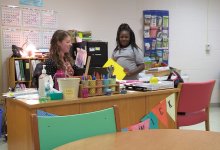Trauma-Informed Practices
Learn what trauma-informed education is, its benefits, and how to get started on a classroom or school-wide level.
Building a Trauma-Sensitive Space
An administrator shares ideas for giving students a place of their own within the school to use when they need an emotional break.342Teachers Need Trauma-Informed Care, Too
Many teachers deal with chronic stress and trauma, and these strategies help focus on adult well-being.431How to Counter Learned Helplessness
For students who have internalized a message that they’re destined to fail, promoting realistic optimism can be game-changing.4.8kBuilding a Culture of Unconditional Positive Regard
A district administrator shares how school leaders can support all students, including those affected by trauma.299How to Safely Manage a Student in Crisis
A trauma-sensitive, proactive plan for safely managing disruptive behavior includes knowing when to call for support and how to help a student de-escalate.1.9kViewing Late Work Through an Equity Lens
A teacher stopped penalizing late work and started asking students questions about why assignments were late. Here’s what he learned.1.9kHow to Make Your Classroom a Healing Place
The stress of the pandemic has impacted students and teachers alike, but taking a healing-centered approach in your classroom can help.1.6kHow Teachers Can Empower Students Who Are Experiencing Trauma
While teachers are not social workers, just saying the right things to a student suffering from trauma can make a big difference.1.6kRecognizing the Signs of Trauma
Trauma may look different from student to student, so it’s prudent to always use trauma-responsive practices.1.8kSteps for Collective Well-Being in the New School Year
Teachers can rebuild connections and create an educational environment in which they support students and each other.1.8kHarnessing the Synergy Between Trauma-Informed Teaching and SEL
Students can develop the core competencies of social and emotional learning with the support of strong relationships with teachers.1.4kBreaking the Cycle of Silence Around Black Mental Health
Data shows that Black youth are especially prone to develop mental health issues but less likely to seek out or receive the specialized services and care they need.1.4kSetting Priorities in Trauma-Informed Education
In this excerpt from her new book, Alex Shevrin Venet explains how she makes decisions that support students who have experienced trauma.1.4k4 Ways to Plan for the Success of Newcomer ELLs
To help newly arrived English language learners feel welcome, teachers can represent their cultures and languages in the classroom.683Using Movement to Help Reduce Students’ Trauma Responses
A variety of exercises that promote self-regulation can function as elements of a safe and supportive learning environment.547














